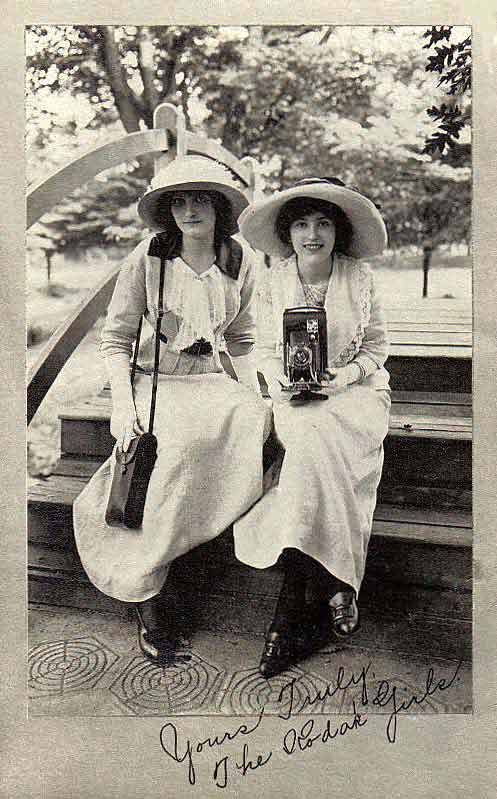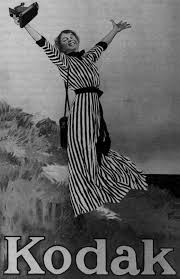The Soul of Christian Lewerer’s Camera
This is a small part of a bigger story of an early Swiss immigrant family who came to Stillwater in 1857 and had connections to the work of the early lumber industry and to Mr. John Runk, himself. The information has been gathered and prepared over many years by Mr. Allen Lewerer of New Richmond,Wisconsin. He is a direct descendant of the early Lewerer family, owner of the camera in this story and keeper of the extensive archives of the Lewerer family. Story written by Robert Molenda.
Christian D. Lewerer’s Kodak 3A Autographic Camera with Accessories. Photo from Allen Lewerer, 2018.
The camera above has been part of a family since 1925. The image maker created connections between historical families, people and places, beginnings and changes. It was designed to be portable and easy to use. It was an elegant technology that allowed ordinary people to record events. Today, it is obsolete. There were innovations in marketing and advertising that brought the excitement and dazzle of the crowded cities of the world to the sphere of the farming communities in Washington County, Minnesota. Although the wet chemistry of silver halide photography is past its prime, the images it produced are still with us today in the digital age. Oddly, the compatibility of the old with the new technology has allowed us to peek into the past and understand and communicate better the changes that have shaped our small part of today’s world. This was the world of The Lewerer Family and Mr. John Runk.
The Kodak No.3A Autographic Camera was treasured by the Lewerer Family. George Eastman sold the first pre-loaded box camera with light sensitive film in 1888. The early box camera could take 100 photos until it had to be sent back to the Kodak factory for the processing of the light sensitive film inside to be processed and printed. The 3A Autographic Camera changed that and made it even more convenient to take photos. What made it invaluable to George Eastman was the fact that the camera could be loaded with light sensitive rolls of film, and when the roll was exposed, only the roll of film had to be sent for processing and printing.
The camera was expensive, yet early families thought it useful and novel enough to warrant the expense. This is where John Runk, in Stillwater, Minnesota made it dear to himself as well. John was famous for taking many archival photos of Stillwater and the surrounding area. In this case, he was also responsible for starting others on the road to becoming good photographers. He had a photography shop in downtown Stillwater at many different locations during his lifetime. His own camera was a bulky affair that used coated glass plates and later coated paper emulsions. It was heavy and not very portable. The light sensitive coatings were slow and required long exposure times. The new No. 3A Autographic Camera was easier to use and opened up a market for others to become photographers.
What separated his work from other photographers was his ability to document via a graphic record the good times and the not-so-good times of everyday life. John also processed film and made prints for his customers. John had a special offer for customers who had photographs that were of historical interest. He would make free copies for them if they could identify events, dates and people in the photographs. As a result, Minnesota has an archival image collection of life in Stillwater and the surrounding area that paralleled the history of photography itself.
This very camera and accessories were sold to Mr. Christian D. Lewerer in 1925. John Runk had a habit of handwriting his sale receipt on the instruction booklet itself. In the case of this Kodak No.3A, the total cost was $61.00.
Instruction Booklet with Receipt signed by Mr. John Runk, January 12, 1925. Photo from Allen Lewerer Family Archives, 2018
The price included The No.3A Camera, the 170mm lens, leather case, tripod, extra lenses, flash, 12 rolls of #122 film and an adapter for making post-card size photos. This was not an easy purchase for anyone in 1925. The dollar amount was $61.00, but to put things in perspective, that $61 is equivalent to $853.27 in 2018 dollars. In 1925, you could also purchase a brand new Ford Model T with a self-starter for $375. That No.3A Camera was a very expensive luxury for anyone at that time. The Autographic part of theme refers to the trap door on the back of this camera that enabled the photographer to write with a stylus on the film roll to record the date, event, subject and other information. This information was then processed right on the negative.
Ninety three years later, Allen Lewerer, a direct descendant of Christian D. Lewerer, having already archived photos given to him by his family, also took some photos of the camera and its accessories in 2018. The details that you need to notice include the sticker on the box that shows the “Square Deal” motto and trademark of John Runk. The box contained the attachments needed to make post-card size photos. Other details include the instruction booklet and the signed itemized list from Mr. Runk. So, we now have established a connection between John Runk and the Lewerer family. A few of the family photos have also appeared in the John Runk Collection at the Minnesota Historical Society. The difference is that Mr. Lewerer’s photos have the identities of the people in the photos. Allen Lewerer did an enormous amount of research on his family and the people in these and other earlier photographs.
There is a strong connection between what was going on in Stillwater in the 1850’s and the role that West Lakeland, Minnesota and the Lewerer family played in the story of Stillwater. The short summary of the role is that there was little farming in the wilderness of Minnesota and Wisconsin at the start of the Lumbering era. You could not deploy men to cut and harvest trees without food, clothing, hardware, firewood, shoes, horses, wagons, cooks, drovers, surveyors and blacksmiths. One barrel of flour was allocated for each person on the logging crew for the entire winter. Food, labor, transportation and provisions were extremely important to a successful logging operation. Crews, horses and oxen had to be acquired, trained, fed and sheltered.
The Lewerer family came to Stillwater in 1857. This pioneer, another named Christian Lewerer, and a blacksmith by trade came here from Stein am Rhein, Switzerland because of the opportunity to work. He worked for the Isaac Staples mill in the early days, then purchased farmland in West Lakeland,Minnesota in 1863. This location is about ten miles southwest of Stillwater. During this time, (1863-1880) he purchased a total of 280 acres of land, which at that time was a large farm. Christian D. Lewerer, born in 1876 in Lakeland, Minnesota, is the grandson of Christian Lewerer, who was born in 1815. The latter boarded a three-masted sailing ship with his entire family in 1853 and came to America. Rudolph John Lewerer, the eldest son of Christian, who was ten years old on his arrival, is the father of Christian D. Lewerer. The West Lakeland area was rich and the entire family was needed during planting, threshing, hay gathering and harvesting. The community included the Lutheran Church, the various cemeteries, the one room schoolhouse, the farmhouse itself, the barn, the flour mill to the north and limestone quarry in the same direction.
Allen Lewerer explained to me that the love of picture taking must be in the genetics of the Lewerer Family. When in High School, Allen learned how to take Black and White photographs with 35mm film and how to process the negatives and prints. His work was for the high school yearbook in 1979. Today, he takes and scans digital pictures for his family. His other projects include doing research on ancestry for his family and others. His most recent project involves taking digital photos from the air using a drone. His work and documentation fit in closely with the spirit and contribution of John Runk of Stillwater. Allen, the family historian, digitized and archived many photos of the Lewerer family and crews of hired-hands, hard at work in the farm fields of West Lakeland. There are also some romantic photos of family picnics taken at nearby locations. There are two in particular that relate to the camera and the story.
Lewerer Family Picnic Taken in late 1920’s
Lewerer Family Members, left to right sitting: Roland Lewerer, Frances Lewerer, Quentin Lewerer, Helen (Lewerer)Richert, Loren Lewerer, Sophie (Riemenscheider)Lewerer, wife of Christian D. Lewerer, Milton Lewerer, Elvira Lewerer; Standing: Christian D. Lewerer, Anton F. Richert(Helen’s husband). Two children from this family are not in the photo: Loretta Lewerer died in 1926 and Carolyn Lewerer who was young and sleeping. Photo from the Lewerer Family Archive, Allen Lewerer, 2018.
The photo above, was taken at a family picnic in the late 1920’s. All of the family members are identified and the patriarch of the family at this time was Christian D. Lewerer. In the background, you can notice a country scene. The picnic was probably somewhere nearby West Lakeland, but it is anybody’s guess as to its exact location. What is really important is to look carefully at the picture of Christian. Did you notice the leather case slung on his shoulder? You should, because it is the same case that Allen photographed for us in 2018. Christian was the family member who purchased the No.3A Autographic Kodak from John Runk in 1925. If you notice, you can also see that the leather case is opened. Could this photo have been taken by this same camera? If only the camera could write or talk. It could certainly record images at the time. There was also a self-timer on the shutter, so that the photographer could be part of the scene. As we drill down deeper into the time period of the 1920’s and the impact that Kodak had on people, we can gain some insight about the camera and of all things,its case.
Keep in mind that this was a time of great vision and expansion. The automobile was affordable and gave everyone a strong dose of freedom and mobility. Picnics were common because of the enjoyment of the great outdoors brought by the automobile. No longer were you limited by how far your legs, your horse or trolley could take you in an afternoon.
The camera case was made of leather. The case was distinctively designed to be taken places, to be seen by others and to last a long time. Kodak was an early advertiser and innovator in the media of the times. The Saturday Evening Post, Cosmopolitan and other magazines were popular at this time. One magazine in particular was The Ladies Home Journal, because Kodak was trying to reach women who were becoming another market for their products. They used “The Kodak Girl”, who was a popular young lady, usually dressed in a striped outfit, showing other women that they were to be seen as free, having fun and creating memories with their Kodaks in the leather case, worn fashionably on their shoulders. The ads told everyone to take their Kodaks with them, to create memories, to send “Kodak Letters”, and to be seen with their cameras. Indeed, the Kodak camera and film created the same level of excitement that we have all experienced when we first used an early i-Phone and were seen using them. George Eastman made it easy for anyone become a good photographer. The strategy was to get everyone to take photographs and leave the chemistry and technical details to Kodak. The other finer details would come later, by educating users how to compose just the right picture, how to set the f-stop, the shutter speed and create artistic photographs. It is no surprise that Mr. Lewerer wore his Kodak case proudly in the photograph. Kodak created a vanity market for this very expensive product that was targeted at the emotions that were fleeting at any event. Now, Kodak made it possible to capture the fleeting moment, and this is what Christian D. Lewerer was doing at the family events shortly after purchasing his camera in 1925. We do not know for certain if his camera was used to take this romantic family picnic of 1925, but it is highly likely that it was used.
These are various Kodak Ads from the 1920’s featuring the leather case holding the 3A Autographic Kodak Camera. The ads featured the “Kodak Girls” and “Taking a Kodak With You” wherever you went. The images are sourced from Duke University Advertising Archives of early Kodak Advertising.
There are additional photographs that are part of the digital collection of Allen Lewerer. Several of these photographs have also been viewed in the John Runk Collection at the Stillwater Public Library, The Washington County Historical Society and the Minnesota Historical Society. When you look at these photos, you see some of the Lewerer family members, but when you look closely, you see Mr. John Runk himself! The photos shown below were taken in 1925 and we know that Christian Lewerer purchased the 3A Autographic Kodak Camera from John Runk on January 12, 1925. You can see Mr. Christian D. Lewerer and his wife, Sophie. In the background is a parking lot with some automobiles nearby to the picnic.
Lewerer Family Picnic with John Runk, 1925. Photo from Allen Lewerer Family Archive Photos, 2018.
Left to right: Anton F. Richert, Christian D. Lewerer, John Runk, Unknown Person, Sophie (Riemenscheider)Lewerer, Unknown Person, Helen (Lewerer)Richert. Photo from Lewerer Family Collection, Allen Lewerer, also Minnesota Historical Society, John Runk Collection.
In the 1920’s you just did not show up at someone’s family picnic. You had to be invited or be a good friend of the family, or a boyfriend or a girlfriend. John Runk could also have been the photographer for this picnic, in which case he would have been invited. He was also known for taking “selfies” using the automatic time-release shutter on the camera. We know that he conducted business with Christian D. Lewerer, because he sold him the No. 3A Autographic Kodak. John Runk never married. Was he a suitor for one of the Lewerer young ladies? Was he just a good friend? How did he get to know the family? Did Runk take the photos at this picnic with the Lewerer family? According to Brent Peterson (Executive Director, WCHS), Runk was always invited to various family and church picnics. What else did the silent but observant No. 3A Autographic Kodak view over its many years in the family? If it could talk, what would it say? Who took the photo?
Today, only a few of us remember taking photographs with rolls of film, setting the shutter speed to the film speed, to the f-stop. Then there was the wait from when you took the photo to when you went to the drug store or photo shop to pick up the prints. They were black and white photos, but there was some anticipated magic in the wait to re-live the moments that were captured by legions of camera-carrying family members. It was expensive to take photographs, worse yet, to waste them with the wrong exposures or other settings. Ever worse, was to disappoint those who wanted to see your work. In 2018, photos are automatic, colored, instantaneous and inexpensive. You can take hundreds of full color photos for pennies and print only a few or all, instantaneously. There was a lot of emotion tied up in the wait for the printed photos to return from the processor in the old days. Is there as much emotion and artistry tied up with today’s technology and computer images? Surely, there is a lot of good emotion involved in sending photos to family members who are far away via Facebook, Instagram or e-mail. Frankly, I still like the wait, the patience that it instills, the capture of just the right photo shot, the framing, the smile, the consideration, the emotions, the pride in sharing the experience of such an event like a family picnic, so long ago.
Even today, children enjoy looking at the old Kodak photos of the family. During the 1920’s there was no television, no video games, and few telephones. Theaters and movies were few and far away, some locations had no electricity and indoor plumbing was a luxury in farming locations. Radio reception was spotty at best. Much of the family entertainment was looking at pictures, reminiscing and dreaming while together. Another example was the popularity of the stereo-opticon photos that showed other exotic places to visit in 3D.
What was the relationship between the Lewerer family and Mr. John Runk? There are many historic photos of Runk with families and with different women during his lifetime. He never married and he never drove a car. He used a pushcart to haul his equipment. He traveled on steamers, on horseback, on public transportation and as a passenger with other friends. Was one of the family members a good friend, a date or was he invited to this exclusive family picnic to show everyone how to use the newly purchased camera? Did he take the photos, or did one of the family members do the job? Did he take the photos with the No. 3A Autographic Camera owned by Mr. Christian Lewerer? If the camera has a soul, it would know the answers to all these questions. Its silence provides honor to everyone involved, yet the graphic capture of the past is there to inspire our own souls.



















